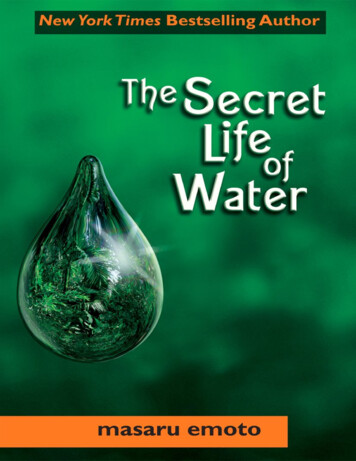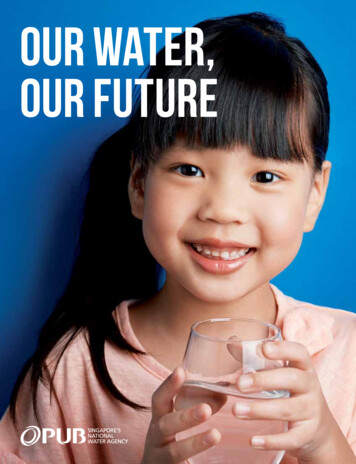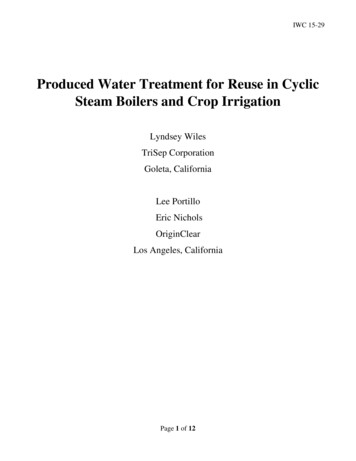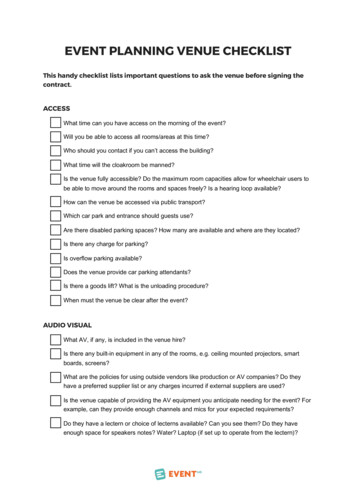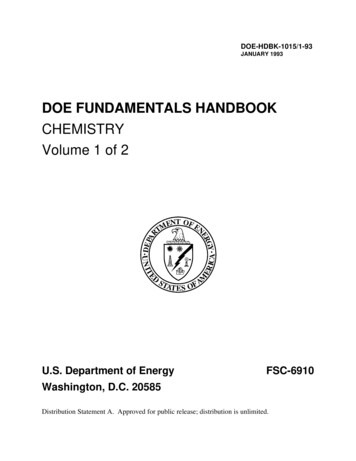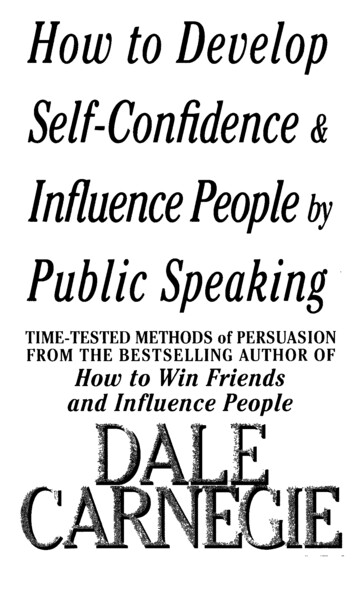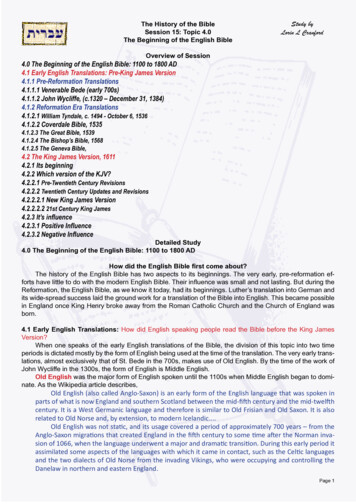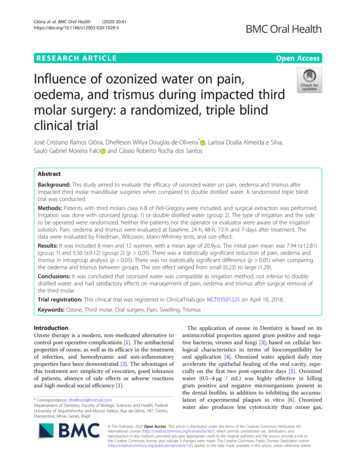
Transcription
Glória et al. BMC Oral Health(2020) ARCH ARTICLEOpen AccessInfluence of ozonized water on pain,oedema, and trismus during impacted thirdmolar surgery: a randomized, triple blindclinical trialJosé Cristiano Ramos Glória, Dhelfeson Willya Douglas-de-Oliveira* , Larissa Doalla Almeida e Silva,Saulo Gabriel Moreira Falci and Cássio Roberto Rocha dos SantosAbstractBackground: This study aimed to evaluate the efficacy of ozonized water on pain, oedema and trismus afterimpacted third molar mandibular surgeries when compared to double distilled water. A randomized triple blindtrial was conducted.Methods: Patients with third molars class II-B of Pell-Gregory were included, and surgical extraction was performed.Irrigation was done with ozonized (group 1) or double distilled water (group 2). The type of irrigation and the sideto be operated were randomized. Neither the patients nor the operator or evaluator were aware of the irrigationsolution. Pain, oedema and trismus were evaluated at baseline, 24-h, 48-h, 72-h and 7-days after treatment. Thedata were evaluated by Friedman, Wilcoxon, Mann-Whitney tests, and size effect.Results: It was included 8 men and 12 women, with a mean age of 20.9y.o. The initial pain mean was 7.94 ( 12.81)(group 1) and 5.50 ( 9.12) (group 2) (p 0,05). There was a statistically significant reduction of pain, oedema andtrismus in intragroup analysis (p 0.05). There was no statistically significant difference (p 0.05) when comparingthe oedema and trismus between groups. The size effect ranged from small (0.23) to large (1.29).Conclusions: It was concluded that ozonized water was compatible as irrigation method, not inferior to doubledistilled water, and had satisfactory effects on management of pain, oedema and trismus after surgical removal ofthe third molar.Trial registration: This clinical trial was registered in ClinicalTrials.gov NCT03501225 on April 18, 2018.Keywords: Ozone, Third molar, Oral surgery, Pain, Swelling, TrismusIntroductionOzone therapy is a modern, non-medicated alternative tocontrol post-operative complications [1]. The antibacterialproperties of ozone, as well as its efficacy in the treatmentof infection, and hemodynamic and anti-inflammatoryproperties have been demonstrated [2]. The advantages ofthis treatment are: simplicity of execution, good toleranceof patients, absence of side effects or adverse reactionsand high medical-social efficiency [1].* Correspondence: dhelfeson@hotmail.comDepartament of Dentistry, Faculty of Biologic Sciences and Health, FederalUniversity of Jequitinhonha and Mucuri Valleys, Rua da Glória, 187, Centro,Diamantina, Minas Gerais, BrazilThe application of ozone in Dentistry is based on itsantimicrobial properties against gram positive and negative bacteria, viruses and fungi [3]; based on cellular biological characteristics in terms of biocompatibility fororal application [4]. Ozonized water applied daily mayaccelerate the epithelial healing of the oral cavity, especially on the first two post-operative days [5]. Ozonizedwater (0.5–4 μg / mL) was highly effective in killinggram positive and negative microorganisms present inthe dental biofilm, in addition to inhibiting the accumulation of experimental plaques in vitro [6]. Ozonizedwater also produces less cytotoxicity than ozone gas, The Author(s). 2020 Open Access This article is distributed under the terms of the Creative Commons Attribution 4.0International License (http://creativecommons.org/licenses/by/4.0/), which permits unrestricted use, distribution, andreproduction in any medium, provided you give appropriate credit to the original author(s) and the source, provide a link tothe Creative Commons license, and indicate if changes were made. The Creative Commons Public Domain Dedication o/1.0/) applies to the data made available in this article, unless otherwise stated.
Glória et al. BMC Oral Health(2020) 20:41chlorhexidine 0.2 and 2%; sodium hypochlorite 2.25 and5.25%; hydrogen peroxide 3% [4].Extraction of third molars is one of the most accomplished procedures in oral surgery [7]. Indications forthis surgery include caries, pericoronitis, periodontalproblems and cysts formation [7–9]. Depending on thelocation, depth, tooth angulation and bone density, thecomplexity of surgical extraction may vary, and is generally associated with post-operative pain, oedema, andtrismus [10].Studies have emphasized the need to improve the control of pain, oedema and trismus on these patients in anattempt to improve their quality of life after surgical procedures [11–14]. Studies have verified the pre and postoperative effects of different drugs and /or clinical management to control these parameters [7, 10, 13].Recently, some strategies have been developed forminimizing postoperative discomfort after third molarsurgery, including the use of pharmacological therapyand alternative medicine [15, 16], and complementaryprotocols have been suggested for the postsurgical therapy of third molar surgery [16]. However, there is a gapabout the effect of the trans-operative irrigation solutionon the post-operative discomfort management. In lightof these findings, the objective of this study was toevaluate the effect of ozonized double-distilled watercompared to double-distilled water, as irrigationmethods, on the postoperative pain, oedema and trismusafter third molar surgery. The null hypothesis was thatthere would be no difference between the two irrigationsolutions analysed.Materials and methodsIt is a randomized, triple blind trial using the splitmouth model. Patients were referred for treatment atthe Surgery and Periodontics Clinic of the Federal University of the Jequitinhonha and Mucuri Valleys(UFVJM), Brazil. This study was approved by the Research Ethics Committee of UFVJM (# 2174074) andwas carried out according to the Declaration of Helsinkiof 1975, revised in 2013. All subjects signed a written informed consent form before the beginning of this study.This clinical trial was enrolled in ingtoCONSORT.Training and calculationTraining and clinical calibration were performed for faceand mouth opening measurements. A single investigator(LDAS) was calibrated at the Periodontics and Oral Surgery Clinic of the UFVJM, using 10 patients (not included in the research) through the test-retest with a 15days interval. The intra-class correlation coefficient was0.886 and 0.814 respectively.Page 2 of 9Sample calculationThe sample size was calculated for comparison of meanvalues, which considered standard deviation of pain 3.32mm [5] and the difference to be detected betweengroups stipulated in 3 mm on the visual analog scale.Level of significance of 95% and power of test of 80%were applied, determining 19 patients. Two patientswere added to cover any dropouts. Patients were recruited between November 2017 and February 2018.Eligibility criteriaThe inclusion criteria were as follows: (1) age between18 and 30 years; (2) good general health; (3) the presenceof bilateral mandibular third molar with class II position,type B impaction according to Pell-Gregory [6]. The exclusion criteria were: (1) any systemic condition whichmight contraindicate the ozone therapy; (2) status ofpregnancy or lactation; (3) acute hemorrhage during thelast 30 days; (4) pericoronitis or signs of infection/inflammation; and (5) smoking habit [17].A pre-operative X-ray was requested. Orthopantomography was used to determine tooth position. Surgerieswere scheduled in two separate clinical sessions, at least4 weeks apart.Allocation of volunteers, randomization and sequencegenerationThe patients selected were numbered from 1 to 21.Through a drawing, group 1 was assigned ozonizedwater (test group) and group 2 double distilled water(control group). The volunteers were randomly assignedto one of the two groups using an accurate dice; if anodd number was drawn, the subject was allocated togroup 1; and even number to group 2. The side to beoperated on was also randomized by an accurate dice;odd number, indicated right-sided surgery; even number,left side. In this sequence, the data was released twiceper patient.The results of the sweepstakes were placed inside twoopaque envelopes, sealed and duly identified with thepatient’s code.Blinding and allocation concealmentInformation on the type of intervention was unknownby the patient, surgeon, clinical investigator (patientfollow-up and outcome measures) and statistician. Theallocation of the interventions was kept secret by a collaborator (JNS) external to the study that was unawareof the research protocol. The opaque and sealed envelopes were stored, and opened only 5 min before the beginning of the surgery at the preparation area of theirrigating solution (ozonized or double-distilled water).
Glória et al. BMC Oral Health(2020) 20:41Ozonized double-distilled waterOzonized double-distilled water was prepared 5 min before the surgeries by an external collaborator of this research (JNS); using the model MedPlus ozone generator(Philozon , Santa Catarina, Brazil) coupled to the glasscolumn with a catalytic converter and microbubble diffuser in stainless steel tube. Double-distilled water absorbs 20 to 25% of all the concentration that is offeredto it [18]. The ozone generator was regulated at 40 μg /mL for 5 min of bubbling in 250 ml of double-distilledwater (Sanobiol, Pouso Alegre, Brazil). The final concentration was 8.0 μg / mL.Double-distilled waterDouble-distilled water (clear, hypotonic, sterile andpyrogenic solution), 250 ml bottle, was purchased fromthe manufacturer Sanobiol.Outcome measuresMeasurements were collected and stored in an envelope,avoiding the access of the evaluator to the previousmeasures.To evaluate the intensity of post-operative pain, ahorizontal visual analogue scale of 10 cm was used, without demarcations, representing the left extremity without any pain, and the right extremity the maximumpain. The patients were instructed to mark with a vertical line the point of the scale that best defined the degree of pain at 24, 48 and 72 h after the surgicalprocedures. These markings were measured with adigital caliper (Mitutoyo ) with two decimal places.Oedema was determined by measuring with measuringtape according to the method described by angulatura[19]. Three measures were taken: 1. corner of the eye tothe angle of the mandible, 2. tragus to the corner of themouth, 3. tragus to the pogonium. The measurementswere obtained in the pre and post-operative periods of24, 48 and 72 h and 7 days. The sum of the pre-operativemeasurements was considered the standard of normalityfor each side. After verification of the measurementsfrom the post-operative period, the difference betweenthe measurements before and after the surgical procedure was observed, determining the level of oedema.Trismus was evaluated by maximum buccal opening.The maximum inter-incisional vertical distance wasmeasured using a digital caliper (Mitutoyo ) with twodecimal places and transcribed in millimeters. Themeasurement considered the distance between the incisal surfaces of the upper and lower right central incisors,after maximum opening without aid, pre-operatively andpost-operatively 24, 48, 72 h and 7 days. The amount ofreduction of the buccal opening was measured and compared to the baseline. Thus, the relative mean for eachPage 3 of 9patient between the final and initial measurements(Delta) was calculated.Surgeries were timed from the moment of the incisionuntil the final suture.Surgical interventionThe surgery was performed in an outpatient setting by asingle professional (JCRG) with experience in oral surgery under strict control within the biosafety norms. Inorder to reduce the differences in intraoperative traumalevel, the same surgical procedure was adopted for bothsides.Iodized polyvinylpyrrolidone-iodine alcohol solution at10% was used in extra oral antisepsis. Regional inferiorand lingual alveolar nerves block was performed, withcomplementation of the buccal nerve anesthesia. A maximum volume of up to 5.4 mL of anesthetic solution (2%lidocaine and 1: 100,000 epinephrine) was used for eachsurgery.The surgeries performed in all cases can be describedas follows: after incision of Avellanal (1946) with a scalpel blade number 15 and removal of the soft tissues toexpose the surgical area, osteotomy at low rotation (30,000 rpm) was performed with a drill 8 and (350,000rpm) with carbide 702C KGS drills (straight piece andpen / Dabi Atlante ), under constant irrigation using a10 cc (ruthe) glass hypodermic syringe coupled to a 10mm (BD) steel needle with doubly distilled water orozonized water according to randomization. Then, thethird molars were extracted with the help of straight Seldin lever, careful curettage, bone regularization andcleaning of the surgical area by means of abundant irrigation followed by aspiration. Suture performed with silkthread (4.0), through isolated stitches, and removed after7 days.After each surgery the patients received postoperative instructions and were prescribed sodium dipyrone(500 mg), 1 tablet every 6 h in case of painful symptomatology; and nimesulide (100 mg), 1 tablet every12 h for 3 days.Statistical analysisThe results were typed and analyzed using the StatisticalPackage for Social Science software, version 25. Thisprocess was carried out by two people (one typed andone checked). The envelope containing the data of eachpatient received a corresponding number in the database. Statistical analysis was initially performed withgroups coded as group 1 and group 2. The decoding envelope of this information was accessed upon completion of the clinical trial and statistical analysis.Descriptive statistics were analyzed to obtain mean andstandard deviation. Data normality was verified by theShapiro-Wilk test. The association between variables
Glória et al. BMC Oral Health(2020) 20:41was verified by Mann-Whitnney and Wilcoxon tests,when pertinent. The significance level of 95% (p 0.050)was considered.To check the magnitude of the differences obtainedbetween the baseline and the last evaluation, the magnitude of effect was analyzed for each group according tothe variable. It was used the Cohen’s d to calculate thesize effect of these dependent variables. The results werecategorized as having a small (0.20 d), medium (0.21 d 0.50), or large (d 0.51) effect [20].ResultsThis study included 8 men, and 12 women, with a meanage of 20.9 years. Of the 41 adult volunteers evaluated,20 did not fit the inclusion criteria, and 1 did not attendthe 48-h post-operative period and was excluded fromthe study. At the end, 20 participants completed the entire research protocol (Fig. 1). There were no intercurrences. Twenty impacted teeth were included in eachgroup. The mean time of surgery was 15.65 ( 6,94) minutes for group 1, and 15.90 ( 5,56) minutes for group2. There was no statistical difference when the meantime between groups was compared (p 0.794).In the 24 h evaluation, the mean pain level of the group1 and 2 was 7.94 ( 12.81) and 5.50 ( 9.12) respectively. AtFig. 1 Flowchart of the included subjectsPage 4 of 972 h, the pain reduced for 5.67 ( 12.83) in group 1, and8.58 ( 10.45) in group 2. There was no statistically significant difference between the groups in the different evaluation times (p 0.05). In the intragroup analysis, nostatistically significant difference was observed betweenthe post-operative times (p 0.05) (Table 1).The oedema reached its peak at the 24-h postoperative assessment (38.35 1.38 in the group 1;38.70 2.07 in the group 2) (p 0.05), and the facialcontour began to resume normal at the 7-days evaluation (37.95 1.54 in the group 1; 38.06 1.99 in thegroup 2). No statistically significant differences were observed between groups at all post-operative times (p 0.05) (Table 2).The initial mean of mouth opening was 47.46 ( 6.92)in group 1 and 48.47 ( 7.22) in group 2. At 7 days, thisopening was 49.49 ( 11.18) and 41.46 ( 7.90) in group 1and 2 respectively. It was observed a significant reduction of the buccal opening in all post-operative periodscompared to the baseline, regardless of the type of irrigation used (p 0.05). However, no statistically significant difference was observed when comparing the oralopening between groups (p 0.05) (Table 3).Delta trismus in 24 h evaluation was 11.75 ( 10.30)in group 1 and 12.57 ( 7.35) in group 2. In both
Glória et al. BMC Oral Health(2020) 20:41Page 5 of 9Table 1 Evolution of mean of the pain scores obtained by VASabPainTimeMean (sd)ppGroup 124 h7.94 (12.81)24 h 48 h 0.27848 h4.73 (5.62)24 h 72 h 0.24624 h 0.65348 h 0.94872 h 0.26772 h5.67 (12.83)48 h 72 h 0.81424 h5.50 (9.12)24 h 48 h 0.94848 h5.50 (9.43)24 h 72 h 0.62972 h8.58 (10.45)48 h 72 h 0.841Group 2aIntragroup analysisintergroup analysisbgroups, there was a statistically significant difference between the evaluation of 24 h and 7 days (p 0.005).There was no statistically significant difference in deltatrismus between groups (p 0.05) (Table 4).In both groups, the effect size was large for trismus(1.19 in group 1; 1.29 in group 2) and medium for pain(0.23 in group 1; 0.43 in group 2) (Table 5).Discussion No previous studies evaluating the effect of ozonizeddouble distilled water (trans operative) on pain,oedema, and trismus after third molar mandibularsurgery were found. Considering ozone therapy anon-drug therapy and with no side effects, it is justified to use it in invasive procedures, such as thirdmolar removal surgery.In order to avoid inter-patient bias in the collection ofthe pain, oedema and trismus levels, the split-mouthmodel was used. Thus, each patient was his/her owncontrol [18] which increases the statistical efficiency.This way, control and study groups were submitted tothe same conditions of feeding, stress, healing, habits(routines and addictions).Previous studies used ozone therapy through gelapplied in the extra oral region immediately after removal of lower third molars, 1, 3, 5 and 7 postoperative days did not show the efficacy of ozone inreducing edema and trismus [5]. Ozonized gel applied to the surgical wound for 2 min, twice daily for3 days, decreased operative pain, oedema and trismus[17]. Ozonized gel, contains stable ozonide which,when in contact with the wound (body temperature),decomposes to reactive active ozone in a prolongedway [21]. We believe that the application of ozonecoincided with the peak of inflammation, which mayhave significantly reduced post-operative oedema inthe study group [21]. The present study appliedozonized double distilled water only in the transoperative period, with no further post-operativecomplementation, which may have influenced thisresult.The literature shows that the time elapsed in surgery correlates significantly with pain, trismus andtotal analgesic consumption [22]. The present studypresented homogeneity of the data between thegroups, due to the absence of statistically significantdifferences in sex, age, dental position, bone removaland / or dental sectioning, duration of surgery, meantime on the operated side and post-operative bleeding, which indicates comparability between groupsand validity of the results. In addition, a single surgeon performed all surgical procedures to avoid interpersonal differences, which could influence theresults.Table 2 Evolution of mean of the oedema scoresOEDEMATimeMean (sd)papbGroup 1Baseline24 h48 h72 h7 days37.17 (3.13)38.35 (1.38)38.33 (1.47)38.25 (1.66)37.95 (1.54)Baseline 24 h 0.003Baseline 48 h 0.045Baseline 72 h 0.028Baseline 7 days 0.25524 h 48 h 0.99924 h 72 h 0.54924 h 7 days 0.13848 h 72 h 0.58848 h 7 days 0.16472 h 7 days 0.147Baseline 0.14224 h 0.32548 h 0.16272 h 0.4747 days 0.589Group 2Baseline24 h48 h72 h7 days38.07 (2.04)38.70 (2.07)38.01 (2.91)38.01 (2.14)38.06 (1.99)Baseline 24 h 0.085Baseline 48 h 0.078Baseline 72 h 0.704Baseline 7 days 0.55024 h 48 h 0.92524 h 72 h 0.06824 h 7 days 0.17248 h 72 h 0.00448 h 7 days 0.07272 h 7 days 0.875aIntragroup analysisintergroup analysisb
Glória et al. BMC Oral Health(2020) 20:41Page 6 of 9Table 3 Evolution of mean of the trismus scoresTRISMUSTimeMean (sd)papbGroup 1Baseline24 h48 h72 h7 days47.46 (6.92)35.71 (12.08)36.74 (12.90)38.93 (10.37)39.49 (11.18)Baseline 24 h 0.001Baseline 48 h 0.001Baseline 72 h 0.001Baseline 7 days 0.00324 h 48 h 0.13624 h 72 h 0.03024 h 7 days 0.00548 h 72 h 0.09448 h 7 days 0.08472 h 7 days 0.421Baseline 0.12624 h 0.60148 h 0.46972 h 0.4217 days 0.433Group 2Baseline24 h48 h72 h7 days48.47 (7.22)35.89 (9.17)37.81 (9.50)38.28 (10.86)41.46 (7.90)Baseline 24 h 0.001Baseline 48 h 0.001Baseline 72 h 0.001Baseline 7 days 0.00124 h 48 h 0.06424 h 72 h 0.17124 h 7 days 0.00548 h 72 h 0.68748 h 7 days 0.00872 h 7 days 0.053aIntragroup analysisintergroup analysisbPrevious in vitro study used ozonized water with thefollowing concentrations: 2 μg / mL, 5 μg / mL and 8 μg/ mL and concluded that 8 μg / mL were more efficientin eliminating Pseudomonas aeruginosa, Staphylococcusaureus, and Enterococcus faecalis [18]. The antibacterialcapacity of the ozonized double-distilled water may havecontributed to avoiding post-operative infections in thepresent study.The present results showed that 8.0 μg / mL of ozonized double distilled-water had no significant impact onpain reduction, oedema and trismus in the postoperative period, when compared to the control group,however, on the intragroup analysis; it was efficient andnot less than double distilled water. A suggested explanation for this result would be the reduced contact timeof the ozonized double distilled water with the surgicalarea, bone and soft tissues. Studies have shown that theeffectiveness of ozonized water depended on several factors such as: contact time, PH and temperature [23].Ozone destroys microorganisms by the progressive oxidation of vital cellular components. The accumulation ofthe oxidation effect due to a longer contact time of theozonized water contributes to a greater reduction of microorganisms [24].The interval between surgeries in similar studies, 2weeks [10] and 3 weeks [17] was extended in the presentstudy to 4 weeks in order to guarantee complete healingof the wound and to eliminate overlap of symptoms aswell as distortion of the results. This favored the studybecause, with a longer interval between surgeries, theconditions of the first surgery did not influence thesecond.As discussed above, the present study was well conducted, presenting internal and external validity.Table 4 Difference of evaluation time minus baseline trismus measurementΔ TRISMUSTimeMean (sd)papbGroup 124 h48 h72 h7 days 11.75 (10.30) 10.70 (9.59) 8.53 (7.18) 7.48 (9.48)24 h 48 h 0.13624 h 72 h 0.03024 h 7 days 0.00548 h 72 h 0.09448 h 7 days 0.08472 h 7 days 0.42124 h 0.35548 h 0.84172 h 0.3987 days 0.573Group 224 h48 h72 h7 days 12.57 (7.35) -10.65 (8.23) 10.19 (9.17) 7.01 (7.87)24 h 48 h 0.06424 h 72 h 0.17124 h 7 days 0.00548 h 72 h 0.68748 h 7 days 0.00872 h 7 days 0.053aIntragroup analysisintergroup analysisb
Glória et al. BMC Oral Health(2020) 20:41Page 7 of 9Table 5 Effect size of the pre and post treatmentCohen’s dGroup 1Group 2Pain0.230.43Edema0.430.01Trismus1.191.29Δ TRISMUS0.601.02Surgical removal of the third molar is followed by therelease of various inflammatory mediators which resultsin an increase in vascular changes, leading to peripheraloedema and local tissue alterations, like pain and trismus[25]. Non-steroidal anti-inflammatory drugs and corticosteroids are the most commonly used drugs in postsurgical period, since they play important role in themanagement of postoperative complications. Thepresent study prescribed a commonly used antiinflammatory drug in both groups. Isola et al. (2019)[15] investigated the efficacy of celecoxib and ibuprofenin reducing postoperative sequelae following the surgicalremoval of impacted mandibular third molars, and theyconcluded that celecoxib shows favourable effects in themanagement of perioperative pain.Pain is caused by inflammation from tissue injury andthe release of pain mediators [26], however, causal factors are not exclusively dependent on the procedure, buta part is also attributed to the patient’s physiologicalcapacity as well as his/her level of anxiety [27]. Pain isconsidered a common consequence in the postoperative period of dental extraction, followed by a decrease over the days [27]. The present result confirmsthis transitory character, probably due to biosafety, professional experience, post-operative guidelines and patient health.Oedema usually occurs in response to tissue traumaon the third molar area. Its evolution is gradual, with apeak of oedema within 48 h after surgery [28]. However,it has been reported that oedema may increase on thethird day, and remain for up to 7 days [29]. The presentstudy corroborates data from the literature that demonstrates an initial edema that resolves within 1 week. Theozonized double-distilled water was as equally effectiveas double-distilled water for oedema control.Trismus usually reaches its peak on the secondpost-operative day and resolves at the end of the firstweek [30]. The present findings indicate that therewas a significant reduction on mouth opening in 24 hand that it was maintained 7 days after surgical procedure. This trismus in both groups can be attributedto the presence of oedema, injury to muscle fibers,multiple penetrations of the needle, elevation and manipulation of flaps, and presence of anesthetic or clotin the muscle fibers.During the third molar removal surgery, transoperative irrigation avoids bone lesions, tissue overheating, and improves operator vision [31]. Saline solution isthe most commonly used as an irrigating solution forthe surgical removal of third molars; however, there arealternatives, for example, sterile water [31]. In thepresent study, double-distilled water (sterile water) wasused as a control because of its easy availability, lowcost, non-irritant, non-toxic, non-hemolytic andantiseptic.The saline solution is isotonic and has similar physiological properties to the natural tissue fluid, however, itis discussed that ozonized saline can produce hydrogenperoxide (H2O2) and chloride ions [2]. Therefore, ozonized double-distilled water was chosen as a test irrigationmethod because of its safety, non-by-product formationand easy manipulation. As explained, double-distilledwater was used as the control so that the ozone effect(ozonized double-distilled water) could be evidenced,avoiding the bias of the irrigating solution.It was expected that the ozonized water could presentbetter result as irrigation solution, since studies haveshown that ozone has good effect/interaction with tissues when exposed in the long run. However, it wassuch effective as the control group. This may be explained by the fact that the present ozonized water wasimmediately aspirated after irrigation, its contact withthe tissues was reduced, consequently inhibiting its effectiveness. This new irrigation solution during surgeryshowed to be not inferior to double-distilled water.Although there was no significant difference betweenozone and double-distilled water in the evaluation ofpain, oedema, and trismus, both agents were clinicallyefficient. Clinical decision-making based on the value ofp has been questioned, and clinical significance seems tobe more focused on the reality of practical and immediate use [32]. Cohen’s d analysis showed clinical importance ranging from medium to large. This implies that indaily practice, ozonized double-distilled water is able toprovide good results on the control of pain, oedema, andtrismus. However, double-distilled water presented thesame behavior of clinical importance.Significant information could not be found in literature on the use of ozonized double-distilled water duringtooth removal. The clinical trial was well delineated,under extreme methodological rigor, however, a limitation of the present study was to find no publications onthe use of ozonized water in oral surgical procedures;being this, a pioneering study, the results can bepreliminary.The present study showed a novel and viable irrigationsolution for third molar surgery. Similarly, the study ofIsola et al. (2019) [16] reported interesting results regarding the management of pain, facial swelling and
Glória et al. BMC Oral Health(2020) 20:41trismus after third molar removal by using a phytotherapeutic drug contained a mixture of herbal extracts suchas baicalin (190 mg), bromelain (50 mg), and escin (30mg). This emphasize the importance of researches inorder to evaluate the potential impact of new treatmentstrategies and alternative drugs linked with postsurgicalhealing following third molar surgery.In view of the present, more studies are needed toconfirm the effectiveness of ozonized double-distilledwater in the reduction of pain, oedema, and trismus insurgery of impacted lower third molars. Further studieswith the use of ozone in gel and / or gas are suggested,as well as the time of contact of the ozone with the tissues should be made longer. It is also suggested to investigate the effect of ozone on short- and long-term pain,for example by measuring the number of analgesicsingested.ConclusionIn conclusion, the ozonized double-distilled water, whenused as a trans-surgical irrigation solution, demonstratedto be viable and safe, presenting satisfactory effects onmanagement of pain, oedema and trismus after surgicalremoval of the third molar.AbbreviationsmL: Milliliters; UFVJM: Federal University of the Jequitinhonha and MucuriValleys; μg: MicrogramsAcknowledgmentsWe would like to thank Mrs. Ivanette D. R. Moreira an
Keywords: Ozone, Third molar, Oral surgery, Pain, Swelling, Trismus Introduction Ozone therapy is a modern, non-medicated alternative to control post-operative complications [1]. The antibacterial properties of ozone, as well as its efficacy in the treatment of infection, and hemodynamic and


